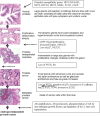The current state of preclinical prostate cancer animal models
- PMID: 18213636
- PMCID: PMC3681409
- DOI: 10.1002/pros.20726
The current state of preclinical prostate cancer animal models
Abstract
Prostate cancer continues to be a major cause of morbidity and mortality in men around the world. The field of prostate cancer research continues to be hindered by the lack of relevant preclinical models to study tumorigenesis and to further development of effective prevention and therapeutic strategies. The Prostate Cancer Foundation held a Prostate Cancer Models Working Group (PCMWG) Summit on August 6th and 7th, 2007 to address these issues. The PCMWG reviewed the state of prostate cancer preclinical models and identified the current limitations of cell line, xenograft and genetically engineered mouse models that have hampered the transition of scientific findings from these models to human clinical trials. In addition the PCMWG identified administrative issues that inhibit the exchange of models and impede greater interactions between academic centers and these centers with industry. The PCMWG identified potential solutions for discovery bottlenecks that include: (1) insufficient number of models with insufficient molecular and biologic diversity to reflect human cancer, (2) a lack of understanding of the molecular events that define tumorigenesis, (3) a lack of tools for studying tumor-host interactions, (4) difficulty in accessing model systems across institutions, and (5) addressing why preclinical studies appear not to be predictive of human clinical trials. It should be possible to apply the knowledge gained molecular and epigenetic studies to develop new cell lines and models that mimic progressive and fatal prostate cancer and ultimately improve interventions.
Figures





Similar articles
-
The use of genetically engineered mouse models of prostate cancer for nutrition and cancer chemoprevention research.Mutat Res. 2005 Aug 25;576(1-2):111-9. doi: 10.1016/j.mrfmmm.2005.02.012. Mutat Res. 2005. PMID: 15885713 Review.
-
Animal models of prostate cancer.Methods Mol Med. 2003;81:89-112. doi: 10.1385/1-59259-372-0:89. Methods Mol Med. 2003. PMID: 12725117 Review. No abstract available.
-
Modeling prostate cancer in mice: limitations and opportunities.J Androl. 2012 Mar-Apr;33(2):133-44. doi: 10.2164/jandrol.111.013987. Epub 2011 Jun 16. J Androl. 2012. PMID: 21680808 Free PMC article. Review.
-
Preclinical Models of Prostate Cancer: Patient-Derived Xenografts, Organoids, and Other Explant Models.Cold Spring Harb Perspect Med. 2018 Aug 1;8(8):a030536. doi: 10.1101/cshperspect.a030536. Cold Spring Harb Perspect Med. 2018. PMID: 29311126 Free PMC article. Review.
-
Drug discovery in prostate cancer mouse models.Expert Opin Drug Discov. 2015;10(9):1011-24. doi: 10.1517/17460441.2015.1052790. Epub 2015 Jun 1. Expert Opin Drug Discov. 2015. PMID: 26027638 Free PMC article. Review.
Cited by
-
Dual PI3K/mTOR inhibitor, XL765 (SAR245409), shows superior effects to sole PI3K [XL147 (SAR245408)] or mTOR [rapamycin] inhibition in prostate cancer cell models.Tumour Biol. 2016 Jan;37(1):341-51. doi: 10.1007/s13277-015-3725-3. Epub 2015 Jul 29. Tumour Biol. 2016. PMID: 26219891
-
Integrative proteomic and phosphoproteomic profiling of prostate cell lines.PLoS One. 2019 Nov 1;14(11):e0224148. doi: 10.1371/journal.pone.0224148. eCollection 2019. PLoS One. 2019. PMID: 31675377 Free PMC article.
-
Generation of Prostate Cancer Patient-Derived Xenografts to Investigate Mechanisms of Novel Treatments and Treatment Resistance.Methods Mol Biol. 2018;1786:1-27. doi: 10.1007/978-1-4939-7845-8_1. Methods Mol Biol. 2018. PMID: 29786784 Free PMC article.
-
Preclinical Imaging of Prostate Cancer.Semin Nucl Med. 2023 Sep;53(5):644-662. doi: 10.1053/j.semnuclmed.2023.02.002. Epub 2023 Mar 5. Semin Nucl Med. 2023. PMID: 36882335 Free PMC article. Review.
-
Dormancy in solid tumors: implications for prostate cancer.Cancer Metastasis Rev. 2013 Dec;32(3-4):501-9. doi: 10.1007/s10555-013-9422-z. Cancer Metastasis Rev. 2013. PMID: 23612741 Free PMC article. Review.
References
-
- Majumder PK, Sellers WR. Aktregulated pathways in prostate cancer. Oncogene. 2005;24:7465–7474. - PubMed
-
- Jong JT. Prevalent mutations in prostate cancer. J Cell Biochem. 2006;97:433–447. - PubMed
-
- Cansino Alcaide JR, Martinez-Pineiro L. Molecular biology in prostate cancer. Clin Transl Oncol. 2006;8:148–152. - PubMed
-
- Rennert H, Zeigler-Johnson CM, Addya K, Finley MJ, Walker AH, Spangler E, Leonard DG, Wein A, Malkowicz SB, Rebbeck TR. Association of susceptibility alleles in ELAC2/HPC2, RNASEL/HPC1, and MSR1 with prostate cancer severity in European American and African American men. Cancer Epidemiol Biomarkers Prev. 2005;14:949–957. - PubMed
Publication types
MeSH terms
Grants and funding
- U01 CA84296/CA/NCI NIH HHS/United States
- R01 CA105402/CA/NCI NIH HHS/United States
- U19 CA113317/CA/NCI NIH HHS/United States
- U01 CA084294/CA/NCI NIH HHS/United States
- P01 CA098912/CA/NCI NIH HHS/United States
- P01CA093900/CA/NCI NIH HHS/United States
- 2P50 CA69568/CA/NCI NIH HHS/United States
- R01 CA101904/CA/NCI NIH HHS/United States
- P50 CA069568/CA/NCI NIH HHS/United States
- U01 CA084296/CA/NCI NIH HHS/United States
- P01CA098912/CA/NCI NIH HHS/United States
- P01 CA104106/CA/NCI NIH HHS/United States
- P01 CA093900/CA/NCI NIH HHS/United States
LinkOut - more resources
Full Text Sources
Other Literature Sources
Medical

